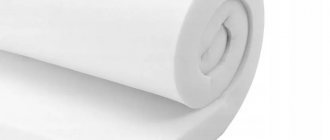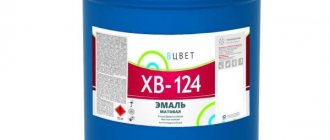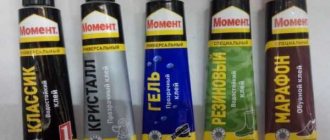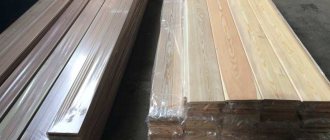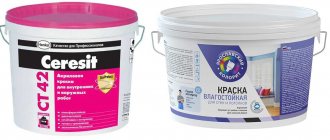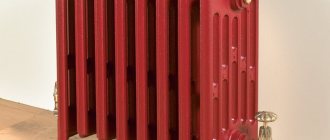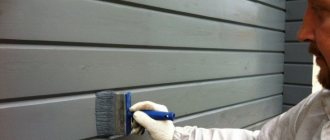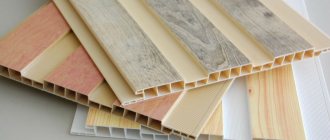During construction and repairs, situations often arise when paint or putty needs to be thinned a little. For this purpose, special compounds are used that do not change the qualities of the source material. White spirit is considered one of the most popular and inexpensive.
What is white spirit?
The composition is one of the types of organic solvents that are obtained through direct oil refining. The name literally translates as “white spirit”. White spirit is a composition that is an oily liquid, classified as a substance with a low level of danger, but if the vapors are inhaled for a long time, symptoms of poisoning may appear. In simple words, this is one of the varieties of light fractions of kerosene or dehydrated purified gasoline. As a result of containing a large amount of volatile substances, it cannot be used as a fuel.
White spirit - composition
The second name of the substance is “Nefras-C4”. It belongs to the group of mixed solvents, which include hydrocarbons of all classes in an amount of 5% of the total mass. The substance does not have any specific formula, because it is made by distillation, and it is impossible to say exactly what the composition will be, because everything depends on the source raw material. There is a type of solvent gasoline that has virtually no odor, this is obtained due to additional purification.
Which is better: ours or imported?
Despite the fact that the production technology is the same, imported white spirit has a weaker odor (and higher prices). This is due to the fact that the product goes through more purification stages, which remove volatile compounds. It’s good - work is easier, there are no headaches and all other symptoms.
Each has its own advantages and disadvantages
The bad thing is that during the cleaning process the dissolving power decreases. This means that fluid consumption will be greater. This is when we talk about adding to paints or mastics. The second point is that the stains will be scrubbed off worse. This is if you use the substance as a stain remover. On the other hand, if you try to remove a stain from fabric with low-purity white spirit, it will be extremely difficult to get rid of the smell (note that repeated washing does not help). It’s clear that the less odorous the liquid, the easier the problem is to solve. Perhaps for this reason, some manufacturers produce this type of solvent in several degrees of purification (for example, Tikkurilla - with blue and yellow labels). Different tools for different tasks.
White spirit - technical characteristics
The main indicators of the substance according to GOST are as follows:
- permissible density of white spirit at +20°C – 0.790 g/cm³;
- boiling point – +160°C;
- 10% is distilled at a temperature of – +170°C;
- 90% – +195°С;
- 200% – +98°С;
- residue after distillation – 6%;
- flash point – +33°С;
- volatility for xylene – 3-4.5;
- mass fraction of aromatic hydrocarbons – 16%;
- sulfur – 0.025%;
- White spirit hazard class – 4.
Advantages of using it before painting
Due to tightening production standards and the need to comply with GOST, the appearance of improved versions of materials has become the norm. This trend has also affected nefras
Consumers should pay attention to a solvent such as white spirit 1050
The production of this substance is carried out, in particular, by. A certificate confirming quality determines the highest class of its products. The features of the solvent white spirit 1050 are the following:
White spirit and kerosene - what's the difference?
These two compounds perform the same functions. Solvent white spirit and kerosene are mixed benzenes that obtain their properties after direct distillation of low-sulfur oil. Both compositions are used in everyday life and production. The fundamental differences between these materials are volatility and viscosity. Kerosene is slightly volatile when compared with the “white spirit”. After use, a thin oil film is formed on the surface. To treat the surface of, for example, a car, it is recommended to use white spirit, which has clear advantages over kerosene.
Analogs
White spirit is considered the most affordable and popular means for thinning paints, degreasing and cleaning surfaces. It is permissible to use other means, knowing what can replace White Spirit. Preference is often given to other petroleum distillation products: gasoline, turpentine, kerosene.
One of these is gasoline, which dilutes paints, bitumen, and mastic well. The flammable material effectively combats greasy stains on metal and plastic and improves the adhesion of the material before gluing.
To dilute alkyd and oil paints, you can choose turpentine. In its pure form, it removes old paint stains.
Several other analogues:
- solvents R-4A, R-5, R-5A, R-12; R-4A is closest to white spirit in composition and properties; R-4 solution contains butyl acetate, which is incompatible with enamels of the XB-124 type;
- solvent - instantly dissolves paints and varnishes, dries quickly and forms a glossy surface;
- FAS-104 is a powerful product used to clean metal surfaces, including those with corrosion (rust).
What is white spirit used for?
Characteristics such as low toxicity, fire hazard, cost-effectiveness and ease of use lead to widespread use in various fields. The main area of use of the product is the chemical industry. The purpose of white spirit is as a solvent in the manufacture of varnishes, paints, primers, enamels and other products. In addition, it is used in the following areas:
- Construction
. Reducing viscosity and diluting paints, varnishes and drying oils. This helps save paint without compromising the quality of the coating. In addition, white spirit is applied to degrease surfaces. - Automotive industry or car service
. The surfaces of various parts are degreased, components are washed, and mastics are prepared. - Leather industry
. Used to dilute compositions for tanning leather and imparting certain qualities to them. - Pharmaceutical industry
. The production process of certain medications. - At home
. During repairs, paints are diluted, and during maintenance, old grease is removed. In laundries it is used to remove various stains.
Does white spirit degrease or not?
The answer to this question is yes. Any metal products can be processed, especially those that are being prepared for painting. Having figured out whether it is possible to degrease a material with white spirit, you need to know that in addition to this, its processing does the following:
- removes all contaminants obtained during operation;
- remove traces of liquids with which the material has come into contact.
Having studied white spirit - what it is, it is clear that the effect of such operations is the appearance of small stains; if any coatings are then applied, this is not significant. In addition, white spirit is used for processing plastic and glass. The substance has a gentle effect on almost all objects. This is a suitable option for treating any surface before gluing.
Can paint be thinned with white spirit?
Initially, this composition was produced exclusively for these purposes. It is now very popular due to its availability and wide range of uses. When looking for information on how to dilute paint with white spirit, you need to know that the composition is suitable for oil and enamel types, as well as various paint and varnish products. Depending on the amount of solvent, it can be used not only to dilute liquid paint, but also to dissolve dried paint without damaging the surface.
Application area
White spirit is used mainly as a solvent for any fractions of oil, sulfur compounds, nitrogen, and oxygen. It can also dissolve vegetable fats. The ability to dissolve fats is used if it is necessary to clean the surface before priming, applying paint, etc. It is actively used before applying paint and varnish coatings (LPC) to metals.
Before painting metal, it should be treated with white spirit - the paint will stick better
For cleansing
You should not use this solvent to clean fabrics or highly absorbent surfaces - you will struggle with the smell for a long time and persistently. It is very difficult to defeat him. The most effective method is treatment with hot (superheated) steam. So that the substances that give the smell heat up and evaporate. It is worth knowing that white spirit begins to boil at 165°C, and evaporates completely at 200°C. If it is possible to heat the surface to a similar temperature, the volatile substances evaporate and the smell becomes less.
There are no such problems with smooth surfaces - it evaporates instantly. Outdoors or in a well-ventilated area, the smell is faint. During renovations and construction, mineral spirits can be used to remove old paint, putty, oil and grease stains. Another useful property is that it removes well the glue that remains after removing the tape and rosin stains.
No need to pour solvent - slightly moisten the edge of the cloth or sponge
White spirit is also used to degrease natural leather. Since there is no chlorine in the composition, it does not change the properties, color and texture. It can be used to protect or “treat” wood from mold and fungi. The liquid penetrates deeply into the pores, destroying the source of damage. In addition, the paint adheres better and consumption is reduced. That is, white spirit can be used as a primer and antibacterial protection for wood.
As a solvent
Despite the fact that the dissolving ability of white spirit is average, it is often used for diluting many compositions to the desired consistency. In this case, a solvent is introduced into the composition, and not vice versa. Mix thoroughly until smooth. As a solvent, white spirit is used with the following compositions:
- oil paints;
- antibacterial impregnation for wood;
- drying oil;
- alkyd enamels;
- alkyd varnishes;
- bitumen mastics;
- rubber mastics.
It is better to work with gloves, use a wooden stick
When combined with paint, white spirit reduces its viscosity. The composition is better applied and distributed, consumption is reduced. But it is worth remembering that after drying the surface will be glossy. If you need a matte finish, look for another solvent.
Dilute to a more liquid state with white spirit and putty. But only those that have an appropriate basis:
- ML - melamine,
- M - oil- and alkyd-styrene;
- PF - pentaphthalic;
- MP - urea;
- VN - divinylacetylene.
White spirit is popular among car owners as a means of removing car mastics. Cleans any bitumen-based compounds and oil shale mastics. Well removes lubricants that are used to treat parts to protect against corrosion (car preservatives). Just remember that the liquid is highly corrosive. That is, you should not allow prolonged contact with the surface. If a puddle has formed, it must be quickly removed and the area wiped dry.
Easily removes stains from car paintwork
How to use white spirit?
Once purchased, the composition does not require any preparation before use. Knowing that white spirit is a composition for solving many problems, you need to know how to use it correctly. To do this you need to follow a number of simple steps:
- open the lid and pour in a small amount of white spirit;
- stir well until a homogeneous mass is obtained;
- repeat all steps until the desired consistency is achieved.
One of the important parts of use is human safety rules when working with this substance. Precautions include the following:
- The use of protective clothing and a respirator is mandatory.
- It is necessary to ventilate the room, because a high concentration of vapors can affect the nervous system.
- Avoid exposure to direct sunlight, which can lead to fire.
- Close the lid tightly after use and store in a dark place.
- Prohibited use near open flames.
How to get rid of the smell of white spirit?
Despite the large number of positive aspects of use, there is one drawback - an unpleasant aroma that remains on all surfaces with which the composition came into contact. If it is not possible to purchase odorless white spirit, you need to know how to get rid of it. To get the desired result, you need to know the following methods:
- Things are soaked in clean water for 30 minutes. Then change the water and hand wash with laundry soap and washing powder. Rinse twice: in vinegar and soda, and then in clean water.
- After contact with skin, you need to shower and rub your body with antibacterial soap. The area can be wiped with a vinegar solution (1:1) or lemon zest.
- The smell of white spirit is removed from the car interior using coffee beans, soda or starch. Treat the surface with any method, remove the residue with a vacuum cleaner.
- You can refresh the room by hanging wet towels, ventilating the room, placing a container of water and mint, or turning on the aroma lamp.
- You can clean furniture or carpet with soapy water or coffee beans.
Safety precautions at work
Despite the low hazard class of the product, precautions must still be observed. When working with the solvent, you should wear rubber gloves and a face mask.
It is advisable to protect your eyes with transparent glasses and your hair with a headscarf. The room should be well ventilated. It is forbidden to leave containers with the dangerous substance white spirit in the sun; it is forbidden to work outdoors.
Other norms:
- do not store the solvent in direct sunlight, near electrical appliances (including lamps, lamps) and open fire;
- work intermittently, ventilating the room;
- carefully open the container with nefras composition, away from objects that can create a spark and cause a fire;
- do not use compressed air to pump the solvent - it is poured manually;
- Keep sand, foam, fire extinguisher or thick cloth on hand to fight fires caused by flammable substances.
After treating surfaces and diluting paints, the canister with the substance should be tightly closed. White spirit should be stored out of the reach of children, and away from sunlight and objects that can get hot.
Protective means.
Symptoms of poisoning
White spirit has a toxic effect on the human body. Prolonged inhalation of the vapors of the composition can lead to poisoning, as evidenced by severe headache, dizziness and nausea.
Often after working with the nefras mixture, drowsiness and weakness, pale skin, and lacrimation are noted. People prone to allergic reactions and skin diseases may develop a rash on their body.
If even 1-2 symptoms are present, you must stop working immediately. If your condition worsens, be sure to seek medical help.
Storing White Spirit
The solvent can be stored in a tightly closed canister or bottle at a temperature from -40°C to +40°C. Containers containing white spirit should not be exposed to sunlight.
It is prohibited to place the product near sources of fire and heat. To avoid an accident, the bottle with the dangerous composition is placed in a place that is difficult to reach from children and animals. The shelf life of the product is 36 months from the date of production.
What to replace white spirit with?
Given the great popularity of the composition, there is no need to be upset when it is not at hand at the right time. You can replace white spirit degreaser with the following substances:
- turpentine;
- gasoline;
- solvent P4;
- FAS-104;
- technical gasoline;
- solvent.
Currently, you can find a wide variety of solvents on sale, each with its own advantages and disadvantages, as well as application features and cost. There is no single alternative to replacing white spirit; in each individual case, you need to select a product based on the needs and specifics of using the composition.
Packaging, storage and transportation
The product description must include an indication of the labeling. Russian manufacturers produce solvent under the brand name “Nefras-S4-155/205”. In addition, the international name “white spirit” is indicated on the packaging in Cyrillic.
In industry, the solvent is poured into PVC containers, the volume of containers can be: 0.5; 3.0; 5.0; 10.0 l.
There are no strict rules for packaging this substance, so you can find completely different packaging options on the market.
If it is necessary to consume solvent on an industrial scale, it can be bottled and packaged in large steel barrels with a capacity of 216 liters. Depending on the parameters and use of the solvent, the guaranteed shelf life of the latter can be from 3 to 10 years. The required temperature regime for storage rooms is from -40 °C to + 30 °C, the light mode is a dark warehouse.
The transport container with the prepackaged solvent is marked with a label containing an image of a unified danger sign according to State Standard 19433, class III, classification code 3319, as well as the necessary handling signs according to State Standard 14192 “Fragile. Carefully".
White spirit poisoning
Any solvent is toxic to the human body, therefore the use of white spirit is allowed only after using personal protective equipment for the skin and mucous membranes. The following toxic effects of the composition have been established:
- damage to the central nervous system;
- damage to the structure of the circulatory system;
- toxic liver damage;
- severe poisoning of kidney cells.
Similar problems can arise as a result of the following situations:
- lack of personal protective equipment;
- technical process failure;
- poor room ventilation;
- failure to comply with safety regulations;
- damage to the container in which white spirit is stored;
- accidental use.
If you detect the negative effects of white spirit, you should immediately go to the hospital. Poisoning is expressed:
- chest pain;
- pain in the stomach;
- nausea;
- vomiting blood.
Release form
The wash is packaged in bottles of 0.5, 1, 5 and 10 liters (container weight is indicated in kg), and the packaging material differs. Thermoplastic is suitable for small volumes, and for large bottlings, low-pressure polyethylene canisters are chosen.
The composition is produced in glass or plastic containers with polyethylene stoppers.
In the future, packaging in wooden, plastic or cardboard boxes is possible. The product manufacturer reserves the right to use any type of packaging that meets safety standards and regulations.
GLOSSARY:
Paintwork solvent (solvent) is a single- or multicomponent liquid that evaporates under certain drying conditions and completely dissolves the film-forming substance of the paintwork material.
Paint thinner (diluent) is a single- or multi-component volatile liquid, which, not being a paint solvent, can be used in combination with a solvent without having a harmful effect on the properties of paints and paintwork materials.
Purpose: for dissolving film-forming agents, for diluting coatings to a consistency that allows them to be applied to the surface to be painted, as well as for preparing and degreasing the surface before painting, washing tools and equipment.
by composition: petroleum, mixed (multi-component), mono (single-component); organic and inorganic;
by evaporation rate (relative to diethyl ether): highly volatile (15).
Volatility is a quantitative characteristic of the evaporation of a solvent (the higher the indicator, the slower the evaporation occurs). This indicator affects the drying speed of paintwork materials. If the volatility index is very high, then the drying of the paint will take longer or unevenly, and if the volatility index is very low, then the solvent may not fulfill its intended purpose - it will not have time to reduce the viscosity of the paint before its application or there will be problems with the use of spray guns.
Acid number is a quantitative indicator that characterizes the presence of free acids in a solvent. A very important indicator, because The solvent must be neutral, otherwise corrosion of the painted surface may occur.
Coagulation number is a quantitative assessment of the dissolving ability of a solvent or the resistance of a paintwork base to sticking when diluted with a solvent.
Flash point is an indicator that characterizes the ease of ignition.
Operating principle
To understand this process, you need to know which component is the main one in a particular coloring composition. Consequently, the solvent is selected with a similar composition. When you add it to dried paint, it will complement its composition and replenish the evaporated part of the base. Thus, you will be able to achieve almost its original condition. The main thing is to thoroughly mix the components together, reaching to the very bottom, so that the solvent does not float on the surface and the composition becomes uniform in thickness.
simple rules
- The dishes in which you will do the work must be clean. No dried paint fragments from previous uses and no small debris. Rinse it with water and wipe dry.
- The most suitable containers are those that have a cylindrical shape with smooth walls. In such a vessel you can move the components as evenly as possible.
- If we are talking about paints that must be diluted with water, then its part should be no more than 10% of the total mass.
- In alkyd enamels that will be used for exterior work, it is necessary to add no more than 3% of the total amount of liquid.
- For interior work – no more than 5%.
If you add too much solvent, your paint will not adhere and will simply run off the surface being treated. This is especially true for vertical planes, on which drips instantly form. At the same time, the performance indicator and service life of the coating are reduced. Let's take a closer look at the most common types of interior paints and the types of solvents suitable for them.
Treatment
Treatment of poisoning with this solvent is carried out in intensive care units. It is even better if all detoxification activities are carried out by a toxicologist. As detoxification therapy, infusion of Hemodez or Trisol is used. Hemosorption and plasmapheresis are also indicated. Only comprehensive treatment can speed up recovery and can save the patient’s life in severe cases.
In case of breathing problems, the patient is connected to a mechanical ventilation system. Oxygen therapy is indicated. Plasma-substituting solutions are injected into the blood. If a large surface of the skin is burned, then surgical removal of the affected areas is performed.
All therapeutic measures are aimed at quickly removing the toxin from the body and maintaining all human vital functions. This is why respiratory and cardiac support is provided first in emergency care. Then symptomatic treatment is carried out.
Manifestations of chronic intoxication
You can also get poisoned at work if you deal with this solvent for a long time. Symptoms of chronic intoxication are somewhat different:
- A person’s general blood count indicators are disrupted: ESR increases significantly, anemia develops, and the level of leukocytes increases.
- Asthenovegetative phenomena gradually form. It manifests itself in excessive fatigue of a person, decreased ability to concentrate, and memory impairment.
- Signs of liver destruction gradually intensify. In humans, you can notice a yellow coloration of the sclera and skin. Sometimes the victim is bothered by aching sensations in the right hypochondrium.
- Feeling of pain in the heart and interruptions in its work.
- As a result of chronic intoxication, the patient develops anuria.
- Pain develops in the lower back.
